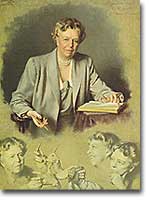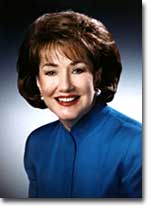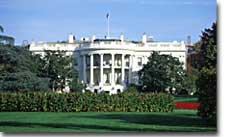7b. All the President's Men and Women

The Office of the First Lady has increased in size since First Ladies such as Eleanor Roosevelt have become increasingly active in public life.
Just as the power of the presidency has grown tremendously in recent years, so have the numbers of people that surround the executive branch. George Washington began his first term with only one aide — his nephew — who he paid out of his own pocket.
Today many advisors in the White House office, the Cabinet, and the Executive Office assist the President. The Vice President and the First Lady also have large staffs that complement all the President's aides.
The Cabinet
The informal advisory body known as the Cabinet is not mentioned in the Constitution. The founders had discussed the idea of some form of national executive council, and George Washington appointed four Cabinet members (Secretary of State, Secretary of the Treasury, Secretary of War, and the Attorney General) shortly after his inauguration.

Elizabeth Dole was the first person to hold two cabinet positions. She was Secretary of Labor under Reagan, and Secretary of Transportation under Bush.
By custom, each member of this advisory group heads a major department, so that their loyalties are almost always split.
Cabinet members must provide good advice to the President. But, they also must promote the well-being of their departments, sometimes at the expense of other Cabinet departments.
Cabinet members are appointed by the President and confirmed by the Senate. They may be dismissed at any time.
The size of the President's Cabinet has increased over the years as Presidents have recognized demands for services and governmental action. As the size of the Cabinet and their respective departments have grown, Presidents have come to rely more heavily on members of the Executive Office and the White House Staff.
| POSITION | YEAR CREATED |
| Secretary of State | 1789 |
| Secretary of the Treasury | 1789 |
| Secretary of War (Defense) | 1789; 1947 (name changed in 1947) |
| Attorney General | 1789 |
 Cabinet members and members of the White House staff often undergo rigorous screening before their appointments. | |
| Secretary of the Interior | 1849 |
| Secretary of Agriculture | 1862 (elevated to Cabinet in 1889) |
| Secretary of Commerce | 1903 |
| Secretary of Labor | 1913 |
| Secretary of Health and Human Services | 1953 |
| Secretary of Housing and Urban Development | 1965 |
| Secretary of Transportation | 1966 |
| Secretary of Energy | 1977 |
| Secretary of Education | 1979 |
| Secretary of Veterans' Affairs | 1989 |
| Secretary of Homeland Security | 2002 |
The Executive Office
Franklin Roosevelt created the Executive Office of the President in 1939 to administer his New Deal programs. Today it consists of several advisory agencies that have worked closely with Presidents, particularly in recent years. The advisers in the Executive Office play key roles in advancing the President's agenda. Three of the most important agencies include the following:
- The National Security Council advises the President on American military affairs and foreign policy. The NSC consists of the President, the Vice President, and the Secretaries of State and Defense. The President's National Security Adviser runs the staff of the NSC and also advises the President.
- The Office of Management and Budget (OMB) is the largest office in the EOP, and it has the job of preparing the national budget that the President proposes to Congress every year.
- The National Economic Council helps the President with economic planning. The council consists of three leading economists and is assisted by about 60 other economists, attorneys, and political scientists. The NEC is the President's major source of advice and information about the nation's economy.
The White House Office
White House Office staff members are not subject to Senate confirmation, nor do they have divided loyalties. They serve the President as an "inner circle" of most trusted advisers. Many have offices in the West Wing of the White House, and they often compete for space as close as possible to the President's Oval Office. Their titles include Special Assistant, Counsel, Aide, and Press Secretary.
Staff members gather information, write reports, give advice, lobby lawmakers, and present the President's views to the media. The Chief of Staff is usually particularly influential as the director of all the operations of the White House Office.
The job of presiding over the nation's government requires many assistants and administrators. Some people have criticized recent Presidents for having such a large staff in the executive offices. Recent Presidents have tried to cut back, but they generally have found that this large, complex country would be difficult to run without them.







